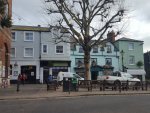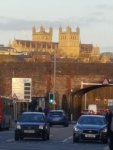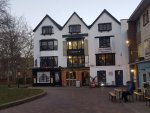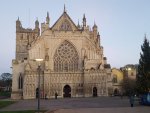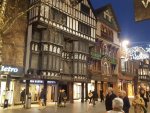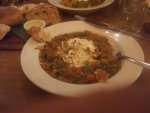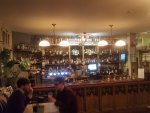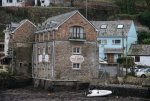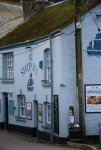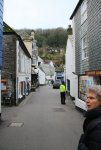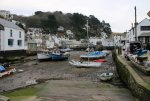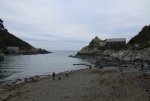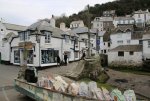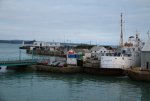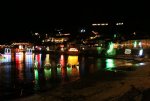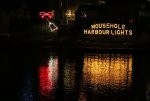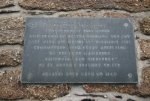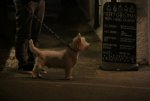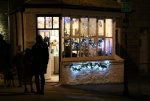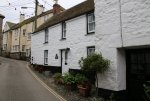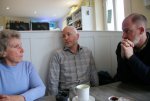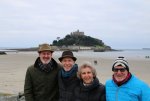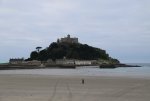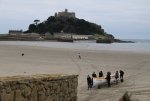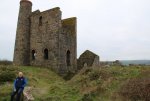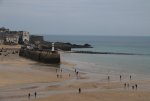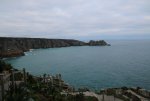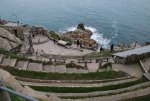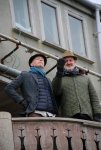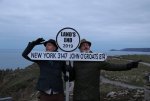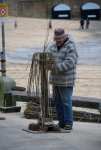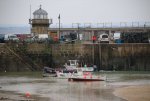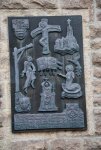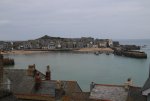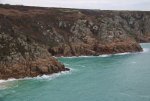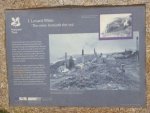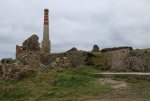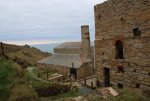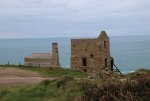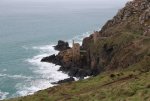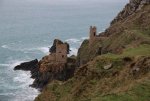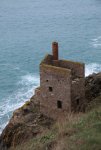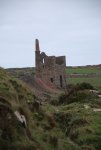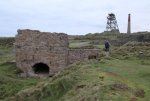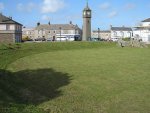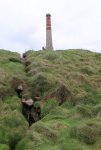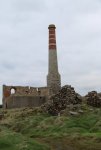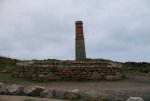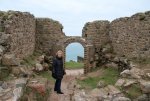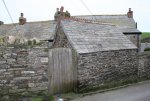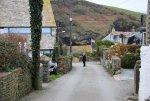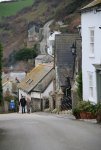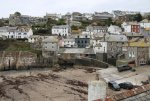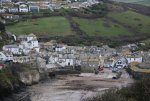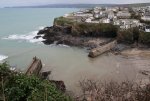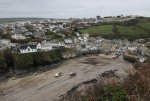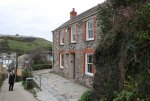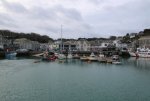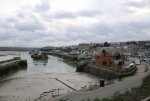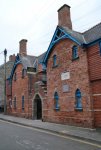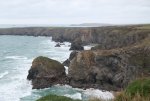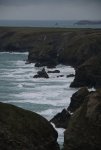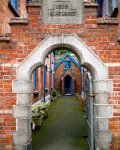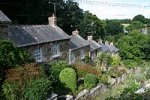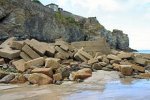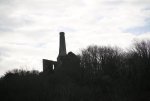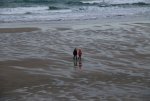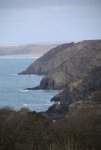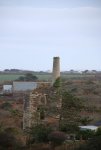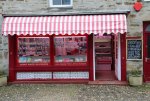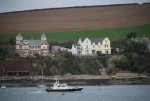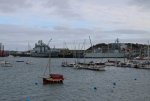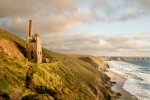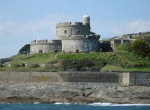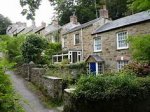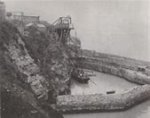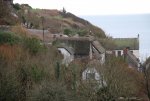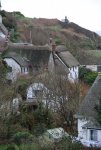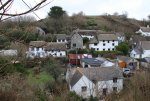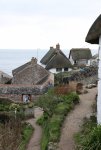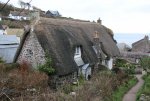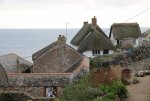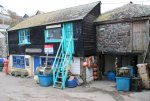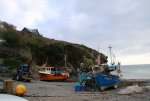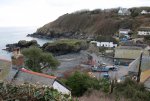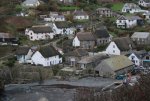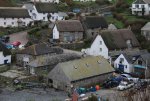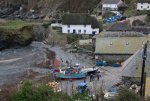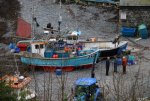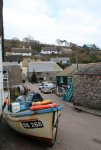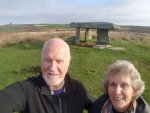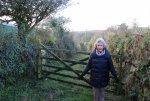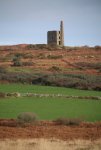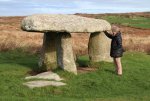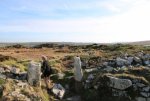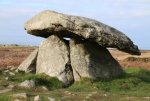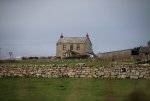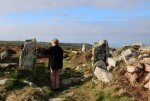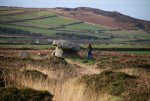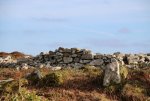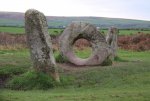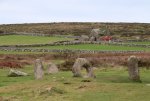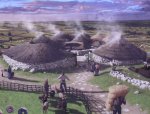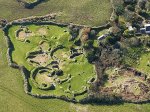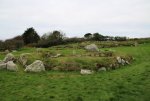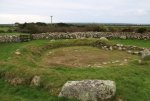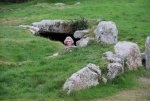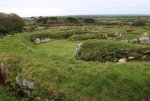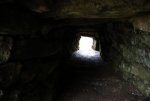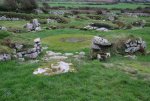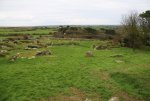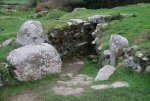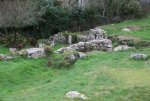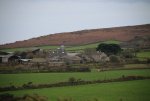12th January
This was the day we went in search of Cheryl's many grandparents in northern Cornwall.
With at least 4 hours driving time ahead of us, largely on 3 and 4 digit roads, we planned on leaving Mousehole by 9:00.
That reminds me. When we first visited England in the early 1980’s, we had read a travel article that recommended that if you want to see the real, quintessential England, you should only drive 3 and 4 digit roads. We did so then, and it was proved correct. It was very much slower driving on narrow roads hemmed in by hedge rows however now in the 21st century, the 1 and 2 digit roads are cluttered with roundabouts with traffic lights and traffic congestion, not much slower.
We woke at 6:30, so were ready to leave by 8:00. It was a dark, gloomy and drizzly morning and as I took luggage to our car, I came across a local walking his pet greyhound. There are as many rescue greyhounds here as at home. Retired from Cambridge, he moved here 3 years ago. His words “most people in retirement travel to see as much of the country or world as possible, I came here and haven’t felt the need to see anywhere else”. He’s seen many gloomy wet winter mornings here, but even he declared, “I didn’t see that coming”. The thick clouds over the sea parted and the sky lit up for just a couple of minutes. Amazing!
For 2 hours, we drove north to Bude. Here is a small town that for the last 4 years has won a gold medal in the British Travel Awards for “Best UK Seaside Town”. Cheryl, Cas and Shar’s antecedents, the Rowlands, lived in three communities within 3 miles of Bude from at least 1600 to the early 1800’s. I dare say they lived here a long time before 1600, we just don’t have the records to penetrate any further back. The mists of time.
Well, the mists were evident for the last hour as we drove across moor and sparse farming country. What they are growing, is wind and solar farms. By 2025, Cornwall will have reached “peak efficiency” in renewable energy. That means, they will be producing as much energy as they can use.
Our first destination is actually 1.5 miles short of Bude. It’s Marhamchurch, a sleepy village of thatch and cob cottages. The village takes its name from St Marwenna, a Celtic saint who founded a hermitage here in the fifth century.
We had decided that as we have no way of knowing exactly where her grandparents had lived, the best bet was that they were at least christened, married or buried at the village church, and that would be our focus. John Rowland and Richard Rowland the 1st and 2nd had lived here in the 1600’s.
Ches was quite taken by the fourteenth century church of St Marwenna, which has an impressive old oak door with wrought iron work, and a 'sanctuary knocker'. To think that her family had most likely touched that door back in the 1600’s, made it a personal connection.
They would also have walked upon the slate floor. Not slate tiles, but blocks of tiles laid vertically. At first we thought they were blocks of wood. They were amazingly soft and warm underfoot compared with the final two churches on our list.
Another feature of all three churches is that their scale is determined by the height of the columns making up the aisles. The columns are single blocks of granite, so around 4 meters was about as high as a single column could be made. This determined the proportions of the arches, often carved marble, and then again, they determined the proportions for the wagon vault roof.
The other notable feature of the church is the large embossed plaster coat of arms of Charles 11 which was installed after the local parish received a letter from him thanking them for their support in the civil war. Similar plaques were on the walls of St Olafs (Poghill – pronounced Puffil) and St Swithens (Launcells).
Marhamchurch, is so close to Bude that no shops have survived in this small village. Non but a village shop staffed by volunteers and largely there to sell newspapers, and emergency rations. We had a brief chat with two of the ladies who’ve lived there for over 20 years and are just beginning to feel like locals. We bought 2 packets of the village biscuits …. Oh! So good.
We drove through Bude, however being Saturday morning, there wasn’t much parking so we headed on to Poghill.
I think I’ve made the point previously that the Cornish aren’t much interested in sign posting anything other than towns. Any touristy site is left to those determined enough to do the research and have the perseverance to find. Kind of like “blind mans buff”.
After wandering “blind” for 10 minutes, we asked locals and were directed to St Olafs church. There was just enough space out front of the church to park. We explored the gravestones surrounding the church; no Rowlands.
Inside, we were again taken by the magnificent wagon vault ceilings.
“The font dates to the 13th century. The south aisle dates to the 14th and 15th centuries. The porch and west tower are dated to the 15th century. The studded door is dated to the 16th century.
The church seats 300 persons and is dedicated to the Norwegian King and so-called Martyr, St Olaf (Olaf II of Norway). At the restoration in 1928 the foundations of the original Norman church were uncovered but nothing of this remains above ground. The pillars on the north side and south arch of the nave are of Caen stone (14th century); those of the south side are granite (15th century). The piscina and aumbry in the south chancel are 13th century.
Inside the church is a wall of frescoes. The frescoes date from about 1470, and depict St Christopher: they were discovered in 1894 beneath the whitewash. Such paintings were once common in churches; the Poughill accounts record the washing-out of the figures in 1550 at the time of the Reformation in the reign of King Edward VI. According to the legend, St Christopher was a heathen giant who, on turning Christian, was instructed by a holy hermit to carry travelers over a dangerous ford, and who, one stormy night carried the child Jesus on his shoulder.”
The frescoes are amazingly bright. To think that after being covered with whitewash for three hundred years, they are still so bright and vivid.
We found a laminated sheet of descriptions of the carvings in the end of the pews. Carved into Oak, around 2/3 of them are deep carvings darting back 500 years to the time of Henry V11. Largely religious but not controversial topics. The Rowlands would have sat in these pews in the late 1700’s.
We photographed most of the pew ends and filmed them as well. In fact, there isn’t much in this church that we didn’t photograph and film.
Once again the Charles 11 crest takes pride of place on the wall. A local told us later that while most of the country parishes supported Charles, pretty well all the fishing ports supported the Parliament.
On one of the walls, there was mention of a famous son of Poughill, Sir Goldswothy Gurney. Obviously much more worthy than the Rowlands. It’s an interesting read:
https://www.revolvy.com/page/Goldsworthy-Gurney
We said farewell to Richard Rowland (5th), who lived here in the late 1700’s before moving to Plymouth where he married Rebecca.
Finally on to Launcells.
This really only consists of St Swithin’s church. It’s a parish rather than a village and even the church is only posted with a small sign low down on the side of the road, and we had to scream to a halt and reverse to take the turn down a narrow road to the church nestled in a narrow valley.
St Swithin’s was described by Sir John Betjeman, as the 'least spoilt church in Cornwall.'
Sir Joihn was a poet, writer and broadcaster who described himself in Who's Who as a "poet and hack". He was Poet Laureate of the United Kingdom from 1972 until his death in 1984.”
As with the other two churches, we were struck by the wonderful wagon roof which was more highly decorated than the others and again the carved bench ends are wonderful and deserve much more time than we gave them. We did photograph and video and purchased a brochure that identified all the major bench ends.
At the end of the blog, I will add all the information I gathered from the internet. It wasn’t easy and I believe that what I have put together is more extensive than anything you might find published in any form.
Among the information I gathered was this:
1st of May 1821: Richard Vinner [? Venner] of Launcells, a labourer, was indicted for; "unlawfully drawing and extracting three quarts of Milk from an certain cow", property of Joseph Hawkey Esq. (who happened to be Landed gentry who resided at Launcells House, aka. now Launcells Barton!)
For stealing the milk. But NOT for stealing the cow.......!
Ches once again touched the door that the Rowlands may have touched between the late 1600’s and late 1700’s when Richard (3rd) and Charity and their son Richard (4th) and his wife Sarah lived there.
By now it was 1.30 and we still had to drive across Devon to the south coast and Dartmouth … and we were running out of petrol and hadn’t had lunch. We managed petrol, a service station sandwich and an ice cream and arrived in Dartmouth at 3.45. It’s not an easy drive on narrow country roads across moor land and through forests and the final 30 minutes is particularly winding narrow roads out to Dartmouth.
Our apartment for the week is a two bedroom penthouse on top of the old post office, right on the riverfront. There may not be a rental in Dartmouth with a better view. Just stunning … and the apartment is very well appointed and comfortable.
Just one hitch …. It’s up 57 steps and we did it frequently over the next week. Starting with this evening, as we discovered that there were to be road closures over the coming week. Instead of just taking up the basics, I emptied the car and took four trips up and down the stairs.
It was now dark and we were hungry however as luck would have it, we were next door to “Rockfish”. Rockfish Dartmouth was the first to open in 2010 and there are now 5 others along the southern coast. What luck. We had a fantastic chowder and followed with spider crab croquettes for Ches and F&Cs for me. Couldn’t fit in a desert, and that started a chain of events in following days.
If you enjoy history as much as I do, the following should be an interesting if long read. Apart from anything else, it's interesting to glimpse what life was like over several hundred years in this small area around Bude. Three communities where the Rowland family lived for several hundred years that we can trace. maybe even further back in time. Particularly, the history of Launcells I have gathered here, you would take days to find searching the internet. How much better would our experience have been if we knew it all before our visit.
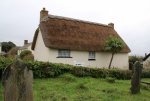
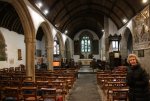
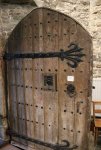
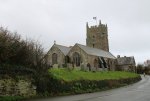
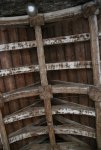
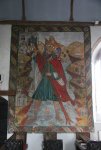
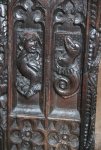
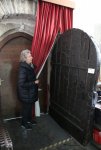
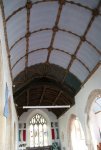
Marhamchurch John Rowland
1600 Honor ?
Marhamchurch Richard Rowland 1 1637 Mary Bate 1643
Marhamchurch Richard Rowland 2 1671 Susan Cowling 1680
Launcells died Stratton Richard Rowland 3 169 Charity Hockam ???
Launcells Richard Rowland 4 1740
Launceston Sarah Elliott 1741
Poughill Richard Rowland 5 1779
Devonport (Plymouth) Rebecca Launder 1776
Both died Antony (Plymouth)
Antony William Rowland 1807 Both emigrated to Australia
Antony 1813 Francis Corny Budge
Victoria Thomas Rowland 1847
1854 Marie Louise Courboules
Victoria Rosalie Rowland 1884 Thomas J Brown
Victoria Shirley Brown 1921 Sydney Steel
Victoria Carolyn, Cheryl and Sharon
Marhamchurch
The name derives from the Celtic Saint Marwenne (Morwenna) who is thought to have founded a hermitage here around the end of the fifth century. Marwenne was one of the twenty-four children of St Brychan , a Welsh saint and king.
Marhamchurch parish church is dedicated to St Marwenne. Most of the present church is of the 14th century; in the 15th century an aisle and porch were added. In the early 15th century the existence of an anchorite's cell occupied by an anchoress called Cecilia Moys is recorded. Features of interest include the four-holed cresset stone and a Norman quarter-capital (though this is unlikely to be a fragment of the Norman church which may have preceded the present building). St Marwenne was probably the same as Morwenna of Morwenstow. In the 9th century the district was probably on the border between Cornwall and Devon and the farms in the parish have Saxon names unlike those of Poundstock on the other side of the River Neet.
Marhamchurch was recorded in the Doomday Book (1086) when it was one of several manors held by Hamelin from Robert, Count of Mortain. There was one virgate of land and land for 2 ploughs. There was one plough, 1 serf, 1 villein, 2 smallholders, 20 acres of pasture and 20 sheep. The value of the manor was 6 shillings though it had formerly been worth 10 shillings.
Marhamchurch Revel is a festival held every year, on the Monday after 12 August in Marhamchurch. During the festival a Queen of the Revel is chosen from the village schoolgirls and crowned by Father Time in front of the church where St. Morwenna's cells are said to have stood. Following these events, a procession led by the local band and the newly crowned Revel Queen then proceeds through the village to the Revel Ground. Here the villagers are entertained with a show of various entertainments.
St Olaf's Church, Poughill
Poughill is a pretty village just a mile from
Bude, full of picturesque cottages of cob and thatch. The medieval parish church is dedicated to St Olaf King and Martyr. The church dates to at least the Norman period, and foundations from that time were uncovered during restoration work in 1928.
One unusual feature of the church are a pair of St Christopher wall paintings, facing each other across the width of the nave. In the medieval period St Christopher was usually painted on the north wall, opposite the main entrance where he could be seen by those entering and leaving the church.
Both paintings have clearly been restored, and the north figure had a crown added. The frescoes date to around 1470 and were discovered hidden beneath layers of whitewash in 1894. The paintings were covered over in 1550, in the reign of Edward VI, when they were considered too Catholic.
Aside from the wall paintings the most interesting historic feature is a wonderful collection of 78 late medieval carved bench ends. Many of the bench ends are carved with the symbols of Christ's Passion, including a wonderfully grotesque carving of the Mouth of Hell. Look for the carving of St Luke's bull and a pelican plucking her own breast.
The nave has beautifully carved bosses dating to around 1537, and the studded south door also dates to the Tudor period. In the tower are the original lychgates.
On the wall is an ornate royal coat of arms dated 1655. The date is remarkable when you consider that 1655 was at the height of Cromwell's Commonwealth, when signs of loyalty to the Crown would have been illegal and quite probably land you in prison at the very least.
Why was the coat of arms installed at such a dangerous time? The most likely answer is that it relates to Sir Bevil Grenville, the exceptionally popular Royalist commander, who was based at nearby Stowe Barton during the Civil War.
The granite font is 13th century, with blind arcade carvings, and there is a 13th century piscina and aumbry cupboard in the south aisle. The south nave arcade pillars are made of granite, while those on the north are of Caen stone from Normandy.
Across from the church is Church House, built as a guild house around 1525 and notable because it is built entirely in stone, where most of the village is of cob. The house stands on land granted by William Dovell, Abbot of Cleeve in Somerset. Cleeve Abbey owned the manor of Poughill until the Dissolution of the Monasteries by Henry VIII.
St Olaf's is a fascinating historic church in a very pretty village. It is usually open daylight hours to visitors and was open when we visited.
Poughill (pronounced "Pofil" or "Puffil") is a village in north-east Cornwall, England, United Kingdom. It is located one mile north of Bude.
History and notable buildings:
Poughill is mentioned in the Domesday Book as Pochelle. Notable old houses in Poughill include Burshill Manor (medieval), an open hall house, and Church House, dated 1525.
The village's water-mill is located on the footpath towards Bush. Lying at the foot of Trevalgus Hill in thick woodland, it is believed to have been a manorial mill for Trevalgus Manor. The mill was powered by the stream which runs south towards Stratton called the Stratt. Part of the mill building was constructed of timbers from ships wrecked along the coastline.
St Olaf's Church
At the heart of the village is St Olaf's church. The church is of exceptional interest and dates from the 14th century. The frescoes date from about 1470, and depict St Christopher.
Battle of Stamford Hill
This battle was fought on the outskirts of Poughill on 16 May 1643. Each May, on the closest weekend to the anniversary, there is a two-day re-enactment of the battle, fought over the Saturday and Sunday, together with a procession through the streets of neighbouring Stratton village.
Notable residents
During the latter half of his life, Sir
Goldsworthy Gurney, the
surgeon,
gentleman scientist,
inventor, and pioneer of applying
steam power, lived in Reeds, a small house on the outskirts of the village, until his death in 1875.
Sir Henry Lovell Goldsworthy Gurney, a
Malaysian colonial administrator assassinated by
Communist extremists during the
Malayan Emergency, was born here in 1898.[1]
Launcells
Launcells is a small parish located in a wooded valley three miles inland from Bude. The parish is composed of scattered hamlets, the main ones being Grimscott and Buttsbear. The parish church is dedicated to St Swithin and was described by John Betjaman as the 'least spoilt church in Cornwall.' The holy well of St Swithin stands nearby. In the Middle Ages the church belonged to Hartland Abbey.
Launcells parish is very much a farming community which, over recent years, like all farming communities, has, through mechanisation, seen a marked reduction in its employment levels.
Totally rural, the parish has a population of nearly 600 people and an area of some 6,200 acres, with just one small community at Grimscott which has a vibrant parish hall (with catering facilities) and which acts as a hub for social, recreational and fundraising parish activities.
Within the parish the only major activities are its farms, a Retirement Home and a large Garden centre which is on the parish border with Stratton.
Launcells Church: The name Launcells or ‘Lancellys’ as it was probably known, means the Church of Cellys. It is likely that there was a Celtic Monastery on the site and St. Swithin’s Holy Well is by the bridge south of the church. The Manor of Launcells was mentioned in the Domesday Book, 1085.
Launcells church was first mentioned about 1200 when it was appropriated to the Abbey of Hartland. The font is early Norman. The church was first dedicated to St. Andrew and then rededicated to St. Swithin in 1321. The church was reconstructed in the C15, the granite north arcade being slightly later than the south arcade, which is of Polyphant.
The porch still contains its old seats and holy water stoup. The windows have perpendicular tracery and clear glass, some of which is very old. Those in the north aisle have been reconstructed.
The original C15 wagon roofs survive, those in the aisles having carved wall plates, purlins and bosses. The stairway to the former roof loft is in the north aisle. One painted panel survives of the original rood screen. The chancel is paved with C15 Barnstaple encaustic tiles. There are over 60 carved bench ends of C16 date.
On the west wall is a wall painting, recently conserved of Abraham and Isaac depicted in Tudor Costume and it is likely that there are paintings under the rest of the wall plaster.
The oldest tombstone, at the entrance to the S porch is dated 1574 and the Chamond monument in the SE of the chancel is dated 1624.
There is a Royal Coat of Arms of Charles II. The oldest of the 6 bells is dated 1751. The pulpit and tester, and box pews in the north aide are Georgian. In the churchyard three chest tombs are listed. They date from late C16 to mid Cl8
Surely weary wayfarers, shared this mysterious and magical place with wandering pilgrims who would have once stopped here at Launcells (Launcellis) on their monumental journeys, resting for a while to partake of its cool and healing waters.
Long before when St Andrew gave his name as its first true dedication, the paganus of this land may have questioned why but still revered its mysterious if not magical powers.
For this sacred spring was here long before disciples of Christ.
As legend would have it, the Holy men of Hartland Abbey who raised the first great granite walls here for Hugo de Moltone, their once powerful Abbot, can it is said, still be heard chanting as the wind sings through the mystical wooded glades of Launcells be it day or by night. And there are those who will swear that the clack of hooves and the swirl of cloaks can still be felt if not seen as daylight fades here, plunging Dub wood into the inky black of night.
In this aged land of legend, as Cornwall rolls back its history, take a closer look at the silent treasure that so many do not know.
A very special treasure that they call, St. Swithins in the Dell.
It is very clear that on this holy site a place of worship had stood as far back as Norman times. A simple structure surely it would have been, solid and forthright, serving purpose rather than offering overt decoration and majesty.
The great Doomsday book complied in 1086 at the order of William the Conqueror, itself cites the existence of the now long vanished Launcells Manor, once standing near here on the hillock behind the church. (This is later referred to as Launcells House, the seat of Richard de Launcells who was something of a mysterious character and a subject I will get onto later.)
Launcells then was cited then as 'Landseu' on the lands of the Count of Mortain.
Launcells entry in the Doomsday Book
Doomsday informs us that; "Alfred holds LANDSEU. Ælfric held it before 1066, and paid tax for 1½ virgates of land; 2 hides here, however. Land for 9 ploughs; 3½ ploughs there; 2 slaves. 3 villagers and 11 smallholders. Underwood, 30 acres; pasture, 50 acres."
Then, during the reign of King John, Matilda the widow of William of Lancells, granted a swathe of woodland and its buildings, known locally as Dub Wood, to Hugo, the Abbot of Hartland Abbey for the princely sum of ten shillings. Where upon tradition has it that henceforth the Abbot would use this secret place in the valley at Launcells as his summer residence and private contemplative chapel.
As with all ancient tales, no one is quite sure what is actually true, but what is known is that in 1261, Hugh de Moltone, sounding remarkably like our Abbot of Harteland, became the very first vicar of what later was to become Launcells Parish Church, so a goodly amount of the account is probably correct.
But time moves relentlessly on, even here in this enchanted valley and it's now been three centuries which have passed since the Augustinian monks of Hartland first built this holy place.
Change was about to come in no small measure and in one fell swoop, it fell upon their Cornish heads.
Henry the King of England, utterly disgruntled by the Papal refusal to grant him a divorce from Catherine of Aragon, made drastic changes to the British religious system, severing all links with Rome and making himself the majestic head of the church of England, principally in order to 'bend the rules so it suited him.'
The British people at this time, viewed the Roman Catholic church as just a money making machine, set and intent on making them pay for everything which traditionally should be free. This included marriages, baptisms and even gaining a rightful a place in heaven by being buried in hallowed ground. So they rallied in great numbers to their King in support.
Henry who was by now legally the self made Supreme Head of the Church of England by an Act of Parliament passed in 1534, now ordered the closure of all the religious orders of England and Wales, including around 800 monasteries, priories, nunneries and friaries and demanded the seizure of all their assets and lands as the wind gathered momentum.
Religious reform, or repression as it was more often termed, had arrived in Cornwall too. Though the country was still primarily Roman Catholic, the Pope’s great power here had finally been ended with Henry left completely in control.
In North Cornwall near the raging and wild Atlantic coastlands, Hartland's monks were granted no favours by King Henry. Unfairly judged by the monarchy as all religious orders were at this time as having been corrupted by the wealth obtained from renting their land.
By others, the brothers were seen as lazy idlers, unhelpful in the community and self centred in their ways. With some orders it was thought, encouraging multiple vices, copious drinking and behavior akin to gluttony.
The monasteries curried little favour in the eyes of the royal court.
So Cromwell was sent in to investigate them, but more so, to interrogate.
Now Cromwell was a hard line officer of the crown, overviewing all monasteries without exception as places full of superstition and excess. Secretive enclaves where veneration of saints and their images encouraged pilgrimages, adultery, unholy excess and purgatory. There could be no real holiness in stones & shrines, its Pagan holy wells and relics. So they would have to go.
Cromwell found these closed and often wealthy holy orders contemptuous and demanded answers to these charges from monks who had after all vowed nothing but silence in deference to God within in their holy order. But, incredible as it may sound, by the breaking of that very silence to which they had pledged and in reply to his insistent questioning, it was simply all that was needed for Cromwell to justify it as a sin in itself and thus sufficient to close them down.
Launcells Castle
Sometime after King Henry's death in 1135 someone decided to build themselves a castle in Launcells but who and why is something of a mystery.
Though little remains of the place called East Leigh Berrys or East Leighburys as others call it, it was probably more a fortified timber hunting lodge than a true blue castle as we know it, such as Launceston castle down the road.
These properties were designed to be more status symbols than castles, simply resembling traditional castles and certainly, with the site being overlooked from most sides, it would have been a poor defensive position to choose to build a fortified building of substance. So we can rule out Kings and Counts moving into the Parish sadly.
Even so it was still a hefty piece of engineering and many men would have been set to work there to construct what seems to be a mott and bailey castle or ringwork of a comparatively low construction but with three conjoined enclaves.
Aerial views are the best to get hold of its size and form because centuries of farming have almost completely erased the castle from the landscape.
At one time the medieval designers would have intended to build in a main entrance gate leading to a central mound on which the principal building would have been raised. All of this would be surrounded by defensive ditches which are clearly visible in the image above.
Quite a feat for marauding enemies or the unwanted to try and surmount, particularly with arrows and stones falling around your ears.
Staunchly Royalist were the fine men of Launcells in North Cornwall.
But this place they call Launcells was never really a village in the true sense of the word but more a grouped parish made up of four hamlets, including Prestacott, Grimscott, Butspur Cross and Hersham and scattered between them both small and great houses and prosperous farms. However, it once sported both Almshouses and a National school at one time but was too widespread to become just one unit and remains, though conjoined, separated by its own quite widespread geography.
For certain however, Launcells back in Charle's time was certainly a Royalist stronghold with Churchtown or Treveglos as it was known , the area around St Swithin's, comprising of but a few small cottages and buildings scattered around the church but long since gone, with the original occupants once serving those principal institutions of the area.
The great Manor of Launcells, rebuilt in George's time as a home also served as a vicarage to St Swithin's for centuries. Latterly this fine building was renamed Launcells Barton, so many people served its farms and offices and other imposing properties of the area and indeed the church itself.
But its one of the few places that does not have a traditional English pub within at least stumbling distance of a church.
The devoted Cornishmen from these rural parts must have played a clear and concise roll in the the defence of the area from Cornwall's enemy the Parliamentarians and even fought at the Battle of Stratton itself, less than a mile distant as the gull flies from the church of St. Swithin at Launcells.
Sadly records do not exist of those Launcells brave and true who bore arms to protect their kinsman and honour, but dimly remembered stories secretly told and proudly kept, bear witness to greater heroics of the Launcell's men and even boys from these parts.
Still visible is the recently uncovered painted text, high on the north wall of north aisle of Launcells church. It pays testimony to the hearts and minds of Launcells men in the days of Cromwell. It is in fact part of a copy of the the text from a letter from King Charles I, dated 1643, in which he thanks his Cornish subjects for their loyal support and sacrifice in their struggle against the Roundheads. ( Transcript below)
C.R
"We are so highly sensible of the Extraordinary merits of our County of Cornwall, of their zeal for our Crown, in a time when we could Contribute so little to our own defence, or to their assistance. In a time when not only no Relief appeared, but great & Probable dangers were threatened to Obedience & Loyalty, of their great & Eminent courage & patience, in indefatigable Persecutions, of their great work against so potent an Enemy, backed with so strong rich & populous Cities. & so plentifully furnish with men, & arms, ammunition, & money, & provisions of all sorts. & of Ye wonderfull success, it hath pleased Allmighty God, through with Ye loss of some great & eminent persons, who shall never be forgotten by us. to reward their Loyalty & patience, by many strange Victory's. over their & our enemies, in despite of all human probability & all imaginable disadvantages, as we can not be forgetful, of so great deserts, so we can not but ever publish to all Ye world, & perpetuate to all times Ye Memory of their Merits, & of our Acceptance of Ye fame & to that end, we do hereby render our Royal thanks to that our County in a most publick & lasting manner, we devise. Commanding copies, here to be printed & published & one of them read in every Church & Chappel, & to be keept & erected in the fame, that as long as the history of these Times & of this Nation, shall continue. Ye memory of how much that County hath merited from us & our Crown, may be delivered with it to posterity".
Given at our camp at Sudly Castle
September the 10th 1643
Every church in 'loyal' Cornwall had and still has the right to display a copy of this letter and many still do, including St Swithins at Launcells, with a proudly framed and well displayed reminder of its not so distant past hanging on the wall of the church adjacent to the organ.
Cornishmen are both devoted and proud men, so after Charles II's Restoration, examples of this letter were often painted on boards and like St Swithins variant, directly onto the plastered church walls, occupying prominent places in many Cornish churches.
No different then was this great Cornish convention at Launcells.
In the beginning of March 1641, near 200 men like those above would have gathered at St Swithin's church at Launcells to listen to their vicar (William) Thomas Warmington. Many of them would have had to stand outside and wait their turn to sign their allegiance to the protestant church and thus to their King.
Reverend Warmington would have likely said these words, reading from the protestation declaration each man in turn had been called to sign.
" Ye good men of Launcells , do ye in the presence of Almighty God, promise, vow and protest to maintain and defend, as far as lawfully you may, and with your Life, Power and Estate, the true reformed Protestant Religion."
Each Launcells man in turn who was in agreement with this proclamation then signed, or more usually made his mark by the side of his name, witnessed by the vicar and the other officials present. Each would testify that the oath had been taken, or refused.
Many in the nation, still of the Roman Catholic persuasion did not put their hand nor their will to it. Few men hereabouts would dare not to.
These long gone men of the parish who are listed below, likely did and irrespective of their status in the hamlet. Man or boy, pauper or the redeemed and revered.
The question is, how many of these men were true to their pledge and in a matter of just a year would be defending Cornwall from the wrath of the Roundheads?
That in itself is a very good question.
Records simply do not exist of those good men and true who fought at the Battle of Stamford hill, just a few miles distant for the freedom of Cornwall, nor of any who gave their lives for the cause.
Paintings of a more conventional type play an important role at Launcells church in Cornwall, with remnants of a huge 17th century wall painting depicting the Genesis story of Abraham sacrificing Isaac still prevalent on one wall, though fading.
Interestingly, as the central characters are depicted here dressed in the peculiarly contemporary dress of the Tudor age, it supports the dating of the artists handiwork well. Sadly, there was until recently great deterioration to the work of art at the hands of time, but has been at least halted by meticulous and expensive restoration. However much more work is required and it is a firmly held belief that St. Swithins at Launcells holds many more fine secrets buried somewhere beneath its replastered and often repaired walls. There is evidence of more throughout the church. But the investment needed to uncover them will be vast.
"The Ringers of Launcells Tower"
< This is an old oil painting inspired by a poem called 'The Ringers of Launcells Tower' by Reverend Hawker of Morwenstow. It was painted in 1887 by the artist Frederick Smallfield, A.R.W.S who was an English painter of genre scenes and a student at the Royal Academy Schools in 1840s.
S. Baring-Gould MA- author of Cornish Characters and Strange Events reminds us that:
"In the Western Counties bell-ringing was a favourite and delightful pastime. Parties of ringers went about from parish to parish and rang on the church bells, very generally for a prize — ''a hat laced with gold."
At Launcells, where the bells are of superior sweetness, the ringers who rang for the accession of George III rang for that of George IV, there not having been a gap caused by death among them in sixty years.
Quoting from Vol; IV of The Parochial History of Cornwall - Hals and Tonkin, the story Frederick Smallfield illustrates is thus:
"It seems the identical six men who rang the bells in Launcells tower on the Coronation of King George III, rang them also on the day of his jubilee, having continued the parish ringers during all that time.
Their names are recorded in the parish, and may there fore be inserted here.
John Lyle, Henry Cadd, Richard Venning, John Ham, John Allin, Richard Hayman.
And of these, John Lyle rang at the accession of King George the Fourth, and of his present Majesty King William IV, being then in his ninety-sixth year : but all are now gathered to their fathers."
The artist visited Launcells from his home in Willesdon in London in 1886 with the blessing of Launcells vicar John Whitmore Black and made copious studies of bell ringers and their movements. Unfortunately he had to work from models for the final product back in the nations capital so sadly, Launcells famous Bell Ringers are not the real gentlemen they represent.
Britain's most famous Poet Laureate, Sir John Betjemen is famously quoted in proclaiming his admiration for the lovely Church of St. Swithin at Launcells, once calling it after a visit; "the least spoiled church in Cornwall." A proudly held dedication which has stuck ever since.
Clearly his observations were very well founded. For it is a church by comparison far less cluttered with added embellishments, statuary and memorial monuments raised to the dear departed than most and not a stained glass window in sight. Of course, exactly as intended.
It is as pure and bright as it had originally been designed with much of its original glass intact. But what Sir John failed to remark upon is that St. Swithin's also holds an even more remarkable secret treasure than its simple beauty.
A visit here reveals row upon row of carved fifteenth century pew ends some 66 in all, each depicting different interpretations of biblical subjects. Ingeniously there is nothing but symbol here and not a trace of a human figure.
No one knows who the ingenious wood carvers were, for the sculpted panels remain unsigned and mysteriously anonymous. Though they are likely local craftsmen who did similar work in other churches nearby.
These ancient bench ends are indeed both unusual and simple in their design, the great hewn panels revealing the secrets of its heart wood to only the inspired medieval carver.
Other commentators have called them 'unrefined', which to a degree I would have to agree with, but they have missed out an additional and important two words here.
They are both absolutely unique and quite, quite beautiful.
Many other fine carvings are to be found here at Launcells church.
Down at the south east end of St. Swithins Church in Launcells are fine examples of intricately carved Jacobean panelling. There is also a Georgian Gothic pulpit and once upon a time, a rood screen, long since dismantled and lost, though the staircase to the rood loft is still intact.
There are parts of the rood screen structure though which seem to have been elaborately painted and decorated, with some that have been reused and incorporated into the pews. Most notably a charming but faded painting on panel of a lily plant forming the back of the pew next to the porch doorway.
Behind the altar, the Reredos is made of polished marble bearing inscriptions of the Ten Commandments. This was a gift of Sir John Call's architect who had rebuilt Launcells House, (now Launcells Barton and latterly the Vicarage) for Sir John's sister, completely without mishap or accident between 1765 and 1777. Clearly an expensive offering of great relief and thanks to God when building sites were dangerous places to work.
Set against the north wall below the arched windows to the left in the photograph above are good examples of Georgian box pews.
Prior to the 16th century Reformation, it was not customary to sit down in church, that is unless you were the Squire or Lord of the Manor. It became customary to do so only much later when the congregation were allowed to sit and then only as recompense for listening to lengthy Sermons.
So to maintain status and hierarchy, it divided 'them' from 'those.'
Box pews like these then allowed for both family privacy where relatives and the invited guests could sit together and were akin to todays status symbols. Private boxes at the theatre or at sporting events.
It was no different here at Launcells, where these private pews were afforded by only the noble and wealthy of the Parish. Unfortunately there is no indication of who sat where in this lovely church but we can guess as some bored adolescents have left us clues.
Another fine treasure this lovely church at Launcells has to offer are the very rare Barnstaple encuaustic tiles which are laid in the nave before the altar. These are in fact inlaid tiles made during the medieval period back in the late 1400's with the colours obtained by using different inlaid types of clay and not by using coloured glazes. The tiles depict Lions, Griffins,Pelicans and flowers and were probably taken up at the reformation for fear of them being destroyed as examples of pagan symbolism. Fortunately our wise vicar of the day who was probably John Grayne - Felde, vicar of Launcells, St Swithin's from 1533 to 1545. Throughout and during the dramatic events of the times. Clearly he was wise enough and knew only too well of their significance and had the foresight to hide them away, as they were found in the vaults when the old flooring was replaced in 1932.
The photograph below only goes to show just how many devout feet have passed this way before.
One mystery that the ancient Church of St. Swithins in Launcells teases us with concerns this great coat of arms. Set into the wall high above the box pews and the old entrance with its stone staircase to the Rood Loft. This is where once the 'Rood Screen,' a decorative barrier separating the 'Chancel,' the space around the altar and the 'Nave' the central approach to the Altar, would have once been fixed.
Now the word Rood comes from the Saxon word for Cross, so we know that at one time, in the church of St. Swithin in Launcells, such a construction actually existed. Likely with a depiction of Christ crucified atop or a more simple rendition of the crucifix set in its central and most symbolic position high above the congregation.
Traditionally the churches congregation was separated from the High Altar itself, which was a holy environment and only one that the priests had access to, so it had a real and perfectly natural purpose. Creating the border to a sanctuary beyond which only those with direct contact with God may tread, or be invited.
Whether the original Launcells church Rood screen contained too many monastic or iconic symbols for the Reformationalists in Henry's time to tolerate and it was hauled down at the order of the vicar, or whether it simply deteriorated with time and fell down, never to be replaced, we just don't know.
Interestingly we do have something of a clue buried in 'A History of Cornwall: from the earliest records and traditions ..., found in Volume 2" by Hitchens and Drew dated 1824:
In which the authors tell us that at the time of its writing, there is still the lower part of a screen" on which figures of the apostles are rudely painted." So at least parts of it were still there back then.
Anyway the mystery of the great Coat of Arms is a bit more of a puzzle.
As we have already seen, Cornishmen were staunch Royalists, supporting their King, Charles the II of England in his defence of the realm against the parliamentary roundheads of Cromwell to the very death.
Such a magnanimous and demonstrative display of support for the monarch that they loved and all that this feature symbolised, indeed all the King stood for, was a very powerful symbol to all. Least of all the local congregation.
It is quite clear therefore that the great work itself would have been created at the time of Charles' reign and unlikely erected as a monument to the King after his death in early February 1685.
After all, a newly ascended Monarch, in this case Charles' brother James II succeeded him and was now on the throne of England, so why put up the previous Kings coat of arms after he was gone?
Local Historians have cogitated and pondered over the years as to who actually made the fabulous coat of arms that hangs in the church at Launcells. But it must be asked. What really is the correct attribution to the creation of this wonderful work of art? It must be asked.
Who then did it?
As tradition has it and indeed is generally agreed upon by the Church of England itself, one man's name has been put forward as a candidate for the creation of it time and time again.
And his name was Michael Chuke, a fine master sculptor who lived locally in Kilkhampton, literally just up the road a pace.
Here was a fine craftsman indeed and a man whose name had also been linked to similar features, sculptures and carvings created in the west country and that are still hanging in churches throughout Cornwall.
So, put two and two together and it was bound to be him.
But there is one problem which emerges from this rather rocky foundation.
Michael Chuke was born in 1679 and the King dead by the year 1685.
So at any reckoning, if he had any part in carving this marvelous coat of arms of his King, he would have been no older than about five when he did!
The one and only tomb effigy in Launcells Parish Church is the one of this man, Sir John Chamond, vel de Calvo Monte, a quiet, well educated and distinguished leader of men and of De Calvo Monte stock.
A lawyer by trade and a noble Knight of the order of St. John, which was an honour bestowed upon him in Jerusalem by Sir Richard Guildford the Master of the Ordinance in the Royal Household of Henry VII. Sir John Chamond was dubbed Sheriff of Cornwall in 1529. Made Steward of the Priory of Bodmin and fully Knighted by his King on the same day as that of his nephew Richard Grenville, the highly respected English sea captain and explorer.
Sir John Chamond served both his Monarch and his successor, Henry VIII. For which he was granted both property, land and title of the Manor of Launcells where he resided following his second marriage into the Parish.
To this day, fallow deer, ancestors of those that Sir John Chamond once kept and bred in his private deer park at Launcells Manor , still follow the same paths around the estate and can be seen timidly feeding at dusk and dawn grazing near the banks of the Neet.
Sir John was succeeded by two sons, one each of two marriages depicted in kneeling positions either side of their father on the monument, (previously illustrated) His son John Chamond the Younger also succeeded his father as a Knight and Sheriff of Cornwall in his own right.
Sir Goldsworthy Gurney is simply put, Cornwall's forgotten genius.
He was a fine engineer and gentleman scientist, far ahead of his time and another great man who is buried at St Swithins church here in Launcells.
Sir Goldsworthy is rightly regarded as one of the leading scientific minds of his age, a brilliant man in his time, or rather, well ahead of his time.
A noted surgeon, prolific inventor, excellent builder and both a scientist and an engineer.
Sir Goldsworthy Gurney turned his hand to many a role, patenting inventions which were as dramatic an innovative in his day as any today.
Though hardly glamorous, his heating and ventilation systems were in use in both the Houses of Parliament and Westminster Abbey, earning him the attention, a national reputation and great the admiration of Queen Victoria who knighted him for his work.
Sir Goldsworthy Gurney is otherwise best known for inventing easily recognisable sequenced lighting for coastal lighthouses and for the implementation and use of of concrete rafts as foundations for buildings, certainly a world changing invention. Notable locally is the one used for the erection of Bude castle, which was raised and built very successfully and primarily on sand dunes much to the amazement of local Bude based sceptics.
But sadly, in the end, his patented Horseless steam driven coach got the better of him and he went bankrupt for nearly a quarter of a million pounds. An incredible sum given the time frame. But after all, the poor man was up against other great inventions and more so, more influential inventors of the time, with inventions and developments in which vast amounts of money were being invested. The railways for instance and his own personal investment and if you will, misdirection by taking his eye off the ball, lost him all of his early found fortune.
Launcells really does have a charmingly fascinating history and from the census of 1841 we know that it had grown considerably as around 860 people lived in this lovely Cornish Parish.
It's interesting to understand what those individuals of working age actually did for a living too, as it gives us a true insight as to what it was actually like here back then in the days of 'them that have' and 'us that don't!'
Primarily then, all that was here for the people of Launcells to enter into was the farming industry and the obvious option to aim for if you were a fit male with no great ambition to do something else in life. So the majority of young people in Launcells entered into employment locally, either working on the commercial farms run by the wealthy landowners of the time, or on the self contained farms supplying those households itself such as Launcells Barton, (above) Magses and Grimscott...
The British census of 1841 tell us that there were all in all 173 Agricultural Labourers living here, with no less than 44 Farmers and 1 Farm Servant.
Now the females of Launcells, excluding those who had a pretty penny tucked away in their petty coats, opted in the main for household duties and there were plenty of options hereabouts for under stairs, maid duty and scullery work, with the bigger houses and farms to choose from in this Parish built of gentry and nobility.
So Launcells back then supported 34, female servants and eleven male helping those out. Most likely the men in a butlering or managerial capacity. Interestingly though, no Gamekeepers are mentioned in the census, though undoubtedly there would have been several.
Serving this widespread community, a variety of other trades sprang up as service industries to the Launcells area.
There were 3 Millers here, no less than 6 Carpenters, a Journeyman who was a master craftsman but we don’t know of what, a Shopkeeper and 3 Cordwinders or ropemakers. There was also wwo Blacksmiths and a Shoemaker. One Mason, 2 Taylor's, 3 Dressmakers and one female apprentice, a Sadler, the Priest of course, an important man called Richard High Keats Buck. Then there was the Inn Keeper and a maltster.
Now this is interesting as back then the Local Pub is listed as the Hobbacott Down Inn, which was sited in the proximity of the canal.
Worthy of speculation is that it was replaced by the Red Post Inn, the name of which is the subject of a whole other chapter on the area and exactly how it got its name..
Moving on, there was one yeoman, a Canal Labourer, a 'Mershanery Man,' who could not spell too well (in other words the Mechanic). There was a blacksmith, naturally, an attorney, eight elderly souls supported by the Union and no less than 5 Paupers in the poor house.
Not to forget eight independently wealthy people who had no occupation at all to decare but plenty of money in the bank!
Although certainly not as built up as it once was, Launcells individuals from the earliest census tell us clearly that they lived both in Launcells Town
( the area around the church which is indicated by an arrow in yellow here) and in West Church Parks at the bottom of the map. Roadsways or tracks linked and circled the whole area back then some 200 years ago..
There seems to be plenty of physical evidence of long demolished workers cottages in the fields around the church near Launcels Barton itself (the old manor house.) As you can see in this early hand drawn map of 1805 with the Churchtown houses all arrowed in red.
Interestingly two more properties can be seen on the bottom left, at the end of the lane leading to Launcells church and where now only an old overgrown path can be found leading from Churchtown Lane ( Lanteglos) and swinging all the way around to Church Park.
Two more houses once stood here at this tiny cross roads.
There was also a cluster of properties where the new rectory now Ravenscourt was to be built and Barton Meadows now stands. That's to the right of the map. And two or three more properties are indicated to have stood in the lane to the west of Church Park in the centre bottom of the map.
We speak of justice in these olden times but has the 'in' been left out of the word?
What follows are not fiction, nor story or even hearsay. They are real and terrible accounts of the times.
All to terrible and real examples of Cornish justice as handed out to Launcells residents in history and as such, taken in the main from quarter sessions records of the time held in archive. Though some examples may be light heartedly amusing to the reader, others are in fact deadly examples of how the law protected the rich and noble of these parts, far and above the normal human being.
Other stories here, we will never forget
Spring of 1199:
Richard de Launcells attacked at his country seat by cohorts of a Lordly landowner, one Henry S. William.
The gang prised rings off his fingers and threatened his life. Some of the accused were; Hugh de Morton, Thomas of Dunham and Hugh of Staddon.
14th July 1741:
Elizabeth Bone of Launcells, aspinster, was accused of petty larceny but acquitted. A Lucky lady!
12th July 1743:
Nicholas Botrell of Launcells, was severally accused of assault and battery to which he confessed: he was fined 1s. and sentenced to remain in custody at Bodmin jail until the next sessions.
15 January 1789:
Elizabeth Herd and Grace Batten, both of Launcells were convicted of taking one goose, the property of John Martin, a yeoman of Launcells ( who happened to be a local wealthy farmer) Property valued at 2d : Sentence: They got one week's hard labour in Bodmin Gaol - each!
9th October 1783:
Thomas Hobbs; previously committed to Bodmin bridewell as a rogue and vagabond was passed back to Launcells, his legal place of settlement as they'd had enough of him.
1st of May 1821:
Richard Vinner [? Venner] of Launcells, a labourer, was indicted for; "unlawfully drawing and extracting three quarts of Milk from an certain cow",property of Joseph Hawkey Esq. ( who happened to be Landed gentry who resided at Launcells House, aka. now Launcells Barton!)
For stealing the milk. But NOT for stealing the cow.......!
Sentence: Six months' hard labour in Bodmin gaol for a glass of milk!
16th October 1821:
William Ham of Launcells, also a labourer, was indicted for taking an oak hurdle, property of Bude Harbour and Canal Co:
So Bodmin jail for him for stealing a piece of wood for the fire!
13th January 1824:
Francis Vinson of Launcells, another labourer, was indicted for stealing a pig, value 6d., property of John Lyle: He got three months' hard labour in Bodmin gaol.
Had this been 30 years earlier he would have probably hanged.
19th October 1830:
Elizabeth Hooper, a single woman of Poundstock ; accused George Simmons of Launcells, a pig-drover of being the father of her unborn child.
He too faced the wrath of the Cornish courts and he wouldn't be the last!
15th October 1841
A jolly old farmer, (who must remain unnamed) approaching to 70 years of age, the father of a family residing in the parish of Launcells, having made the acquaintance of a lady, proposed a walk on the Summer Lane and in his return found himself thirteen pounds lighter in purse, than when he first had the happiness to be introduced to her at the beer-shop, half an hour before. The lady walked off with her spoil without detection.
Friday 31st March, 1843
Mary Jane Fanstone, aged just 12, was charged with having stolen 18 lbs of hay, the property of Mary and Wm. BROCK, of Launcells. And Edward Fanstone, 40 with having received it, he knowing the same to have been stolen. The evidence presented was weak and her father acquitted.
But that did not save poor Mary Jane though and the court never the less sentenced her to One Month's Hard Labour - the second and last weeks to be passed in solitary confinement. Age Twelve eh?
1849 and 1850
Both the national killer Cholera and Small Pox took a heavy toll in Cornwall and more locally in the Parish during the latter half of 1849 and in the following year, it was primarily with the young and particularly Launcells' infants suffering badly with a spate of infant deaths. With all in all some 30 people that we know of perishing, including both adolescents, young adults and the elderly. Though not all will have come to the end of their lives here in Launcells as a result of contracting those diseases, almost most certainly, many did, as it was avast increase in the mortality rate.
Interestingly, there are no speculation or record by writers of anyone from Launcells perishing from the Black death, which decimated Bodmin's population, cutting it by half.
And lastly something etched deep the minds of of many people of these parts:
The day was the 15th of April 1912.
A young and adventurous William Dennis aged 26 a farmer of Treyeo Farm in Launcells, had been encouraged to emigrate to Saskatoon in Saskatchewan, Canada by his farmer relatives; Lewis Richard 29, and Owen Harris Braund 22 of nearby Bridgerule in Devon, so they could begin a new and better life in the Dominion.
An excited William couldn't wait and bade his parents farewel optimistically embarking on the long trip by rail to Portsmouth, along with his travelling companions; the Braund's, his younger brother Samuel just 22, a farmer also and other close relatives, John Henry Perkin (22 of Ashbury, Devon) and John Henry Lovell (20, of Holsworthy, Devon) all apart from one, an ironmonger were farmers. They were joined by a Miss Susan Webber, aged 37 and a family friend of nearby North Tamerton in Cornwall, who was to visit her brother who had emigrated to Canada earlier, for the first time in years.
Tragically with his family and friends, William embarked on the Titanic at Southampton on third class ticket.
His body was never recovered
